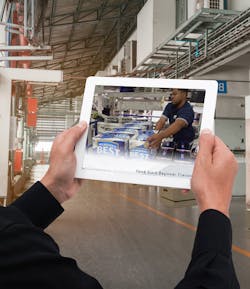Hands down, the best way to learn a task is to actually perform that task.
Learning how to operate machinery, navigate a distribution facility, or install equipment on a busy city street, requires that a trainer physically demonstrate procedures.
There is, however, another training method available. Using technologies such as augmented reality (AR) and virtual reality (VR), trainees can go through realistic simulations to learn what do to and what not to do.
That is especially useful now given restrictions due to the pandemic.
“Companies that had plans to develop AR/VR in training programs next year are telling us they need this capability right now,” explains Nick Day, vice president of sales for Roundtable Learning, a learning and development company that employs a variety of training technologies.
A perfect example of the need to quickly train a workforce is Amazon which has added more than 150,000 workers since the pandemic hit in March. As eCommerce is now the preferred method of delivering goods given in-person restrictions, the company had to scale up at previously unheard-of rates.
“When you are bringing in that number of employees, many don’t have experience in the field so training is a huge challenge,” says Day. “Using methods such as AR/VR which allows employees to simulate actual working conditions saves having to use the more traditional method of asking current employees to allow new employees to shadow them.”
VR also has the advantage of showing every possible situation that an employee might face and let them practice. This wouldn’t be feasible in real-time training.
And while employees are learning, data about their results can be saved. “A manager can review the results and see if there are areas of improvement that can increase the effectiveness of the training,” explains Scott Stachiw, director of Immersive Learning, for Roundtable Learning. “A company can build out a post-training plan to bring training up to the next level.”
Taking it to the Street
Bringing training to the next level was the objective of a project that Roundtable Learning collaborated on with a major telecommunications company. Learning how to navigate a manhole on a city street involves dealing with a lot of variables. So Roundtable created a training program that in addition to taking a trainee through the steps of manhole setup and safety, added in extra dimensions that needed to be considered. The program simulates a busy city complete with buses coming down the street, taxis cruising along and people walking across the street as well as other ambient noises and distractions.
“This method lets us train on cause and effect,” explains Stachiw. An example would be that during a simulation an employee could accidentally step into traffic and the program would show the consequences. This element, of course, wouldn’t be included in regular training but is so important to the safety of the employee.
Better Training, Better Productivity
Robust training can be critical to employee satisfaction. At one national beverage company, it was the lack of training that was causing problems. The company had installed a complicated piece of machinery in its warehouse but training on it was very limited. This limited training capability was causing warehouse workers to become frustrated as it limited their job scope to a specific role. Some were even calling in sick to avoid the situation.
So, the company partnered with Roundtable Learning to develop a series of training videos. The goal was to teach both the function of the various operating areas on the equipment and the procedures needed to do the job safely.
The videos were supplemented by a virtual reality experience which taught safe procedures, including some that could be practiced prior to coming into the warehouse. Associates could pick up cases and stack them on a palette through the VR program and learn the proper way to perform these tasks prior to actually doing the job.
The results of the enhanced training was a 33% reduction in time from training to productive floor work. The company saved 12.5% in training costs.
And the best metric of all was a 50% decrease in worker’s compensation claims.
A Closer Look
A different type of simulation, AR, can be used when learning how to train on a large piece of machinery. For example, Cummins used it to offer training on a complex engine. As the engine can’t be easily moved to a variety of locations many people are trained at the same time.
With AR there is no need for large crowds, as it can be used by anyone at any time. A model of the machine is placed in any location and brought up to real -life-size. The AR program is placed over the model which allows for any part to be brought out to teach employees how to operate that specific part. There is also the capability of attaching videos and documents to the part via AR.
This method is especially useful for those in the field that can bring up the model via AR and get real-time assistance.
These new training methods have other benefits as well when it comes to the general culture of the company. “Giving employees a safe place so they feel comfortable to make mistakes, is the best way to learn,” says Day. “These AR/VR experiences are an easy way to facilitate that learning.”
And of course, this high-tech method of learning is in line with how the next generation of workers like to learn. “This type of training should help a variety of industries attract the talent they need.”
About the Author
Adrienne Selko
Senior Editor
Email [email protected]
Adrienne Selko is also the senior editor at Material Handling and Logistics and is a former editor of IndustryWeek.

